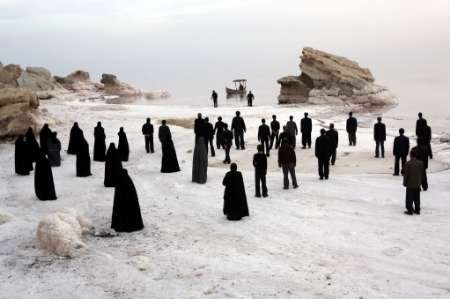 Oroumiyeh, West Azarbaijan Prov, May 19, IRNA � Governor General of West Azarbaijan Province Qorban-Ali Sa�adat said here Sunday evening that saving the dying Oroumiyeh Lake is quite possible and the situation is not worrying, adding that all that is needed for the purpose is strong will and arduous efforts.
Oroumiyeh, West Azarbaijan Prov, May 19, IRNA � Governor General of West Azarbaijan Province Qorban-Ali Sa�adat said here Sunday evening that saving the dying Oroumiyeh Lake is quite possible and the situation is not worrying, adding that all that is needed for the purpose is strong will and arduous efforts.��The top provincial official who was speaking at the opening ceremony of an international agricultural and animal husbandry exhibition in the capital city of the province proposed training the farmers who work on the coasts of the Oroumiyeh Lake to use the modern irrigation methods, which he said will solve many of the problems.
�In last session of Save Oroumiyeh Lake workgroup the establishment of a committee was ratified and that workgroup was commissioned to sum up the proposals made by the Department of Environment (DoE), the Power Ministry, and the Agricultural Jihad Ministry and to present the result to the government,� said Governor General Sa�adat.
He appreciated President Hassan Rouhani cabinet�s attaching high priority to solving the Oroumiyeh Lake crisis, arguing that under such conditions and relying on the scientific and technical surveys launched lately resolving the crisis is much easier than it was previously assumed.
�Optimum use of water must be taken on the coasts of the Oroumiyeh Lake agricultural lands while farming in the northern parts of the province should be promoted instead,� he said.
The West Azarbaijan Province governor general said that farming on the riverbanks of Aras River and in the fertile lands of the Maku Free Trade Zone (FTZ) can be very ideal as the water resources in those regions are ideal.
In order to find a solution for Iran�s drying wetlands with focus on Lake Oroumiyeh and the Hamoun wetlands, an international technical round table with participation of foreign and Iranian experts was held here from March 16 to 18, 2014.
Organized jointly by Iran�s Department of Environment (DoE) and United Nations Development Program (UNDP) the main objectives of the round table were: to review the factors causing the drying of the two specific wetlands and the actions that have so far been undertaken to address these, to share experience and the best practical international approaches for the restoration of drying wetlands and to recommend a series of steps to the government � taking into account known policy, logistical, institutional and budgetary limitations � which can then be shaped for quick implementation.
Across the arid and semi-arid areas of Iran and West and Central Asia there is unsustainable demand for water (particularly for agriculture). The management of this demand, combined with the impact of climate change, is potentially causing an environmental crisis in Iran, a press release issued by the UN Information Center (UNIC) said on Saturday.
The fate of the Aral Sea is well documented. Similar crises now affect wetlands across the region including in Iran. Two wetland systems with international dimensions are of greatest current concern: Oroumiyeh Lake and the the Hamoun wetlands in Sistan and Baluchestan. These precious sites have already lost their ecosystem functioning with catastrophic implications for biodiversity and economic and social wellbeing. Restoration is proving to be extremely challenging.
National, regional and global attention to this crisis needs to be intensified greatly � and solutions need to be identified and then implemented. Despite many efforts nationally, there is an urgent need to also share experiences and solutions from the region and beyond.
The objective must be to secure an evidence-based set of recommendations, place these before decision-makers as the viable steps for solution and then scale-up national implementation to bolster ongoing efforts. The objective will involve the need for international advocacy, and the harnessing of the support of the global community.
The UNDP Iran Office at the request of the Iranian government has invited eminent international and national experts to share their experiences and solutions, and to help formulate a set of specific practical recommendations for these two drying wetlands in Iran.
This could well serve as a basis to addressing the larger issue of conserving other wetlands in the country.
By IRNA
The Iran Project is not responsible for the content of quoted articles.











